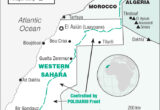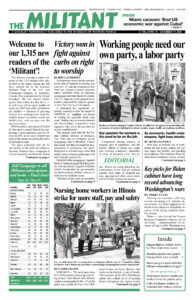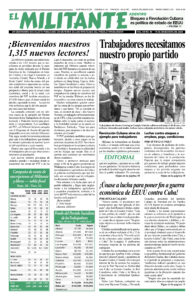 Moroccan government forces attacked Sahrawi civilians in Western Sahara who were peacefully protesting against the monarchical regime extending its wall dividing their country. This has rekindled the national liberation struggle there.
Moroccan government forces attacked Sahrawi civilians in Western Sahara who were peacefully protesting against the monarchical regime extending its wall dividing their country. This has rekindled the national liberation struggle there.
For decades the people of Western Sahara have been fighting for independence and self-determination against Moroccan-government occupation, which has been backed by the imperialist powers of Washington, Paris and Madrid.
Moroccan armed forces entered a United Nations-patrolled demilitarized “buffer zone” in Guerguerat, in violation of a U.N.-brokered cease-fire that was put in place 29 years ago. Guerguerat is located in the southwest corner of Western Sahara close to its border with Mauritania.
Moroccan troops then crossed past the massive sand wall, known as the “berm,” which was built by the Moroccan regime to separate areas of Western Sahara controlled by the pro-independence Polisario Front from that occupied by the Moroccan regime — some 80% of the country. Polisario stands for the Popular Front for the Liberation of Saguia el-Hamra and Río de Oro, the two main populated regions that make up Western Sahara.
The Sahrawi protests in the Guerguerat strip that Moroccan troops fired on were organized in response to the Moroccan government building a road through the buffer zone to the Mauritanian border.
In response, Polisario Front leader Brahim Ghali announced Nov. 14 that attacks by the Sahrawi People’s Liberation Army against Royal Moroccan Army forces occupying Western Sahara will resume.
Solidarity statement
The World Federation of Democratic Youth, which includes the Young Socialists in the U.S., expressed its solidarity with the Sahrawi people’s struggle in a Nov. 15 statement: “We denounce the illegal actions of the Moroccan army. We urge the resolution of this conflict, which cannot culminate in any other way than with the end of the occupation and with the exercise of the right of self-determination of the Sahrawi people, which has been denied to them for so many years.”
The statement calls for efforts to get out the word about “the Moroccan occupation of Western Sahara, the complicity of the ruling classes with this occupation, and about the necessity of supporting the Sahrawi cause and struggles.”
The U.S. government is the largest supplier of arms to the Moroccan monarchy. Rabat also hosts the annual “African Lion” U.S. military exercise in North Africa. Last year Washington approved up to $10 billion in new arms sales to the Moroccan government, including F-16 jets and Apache attack helicopters.
Washington and other imperialist powers have their eyes on the vast phosphate reserves in Western Sahara and rich fishing grounds off its coast, now in the hands of the Moroccan regime, as well as untapped offshore oil deposits.
Sahrawi fight for self-determination
As with many nations in Africa, the borders of Western Sahara were imposed by the main imperial powers of Europe at the Berlin Conference of 1885, a division of the continent for exploitation. Spain’s claim to Western Sahara was codified there.
In the late 1960s, under the impact of the post-World War II anti-colonial struggles that swept through Africa and Asia, Sahrawi nationalists launched a struggle for independence from Madrid.
The Polisario Front, founded in 1973, launched armed battles that forced Madrid to relinquish control over Western Sahara in 1975. But the Moroccan regime then annexed two-thirds of the country and the government of Mauritania took the rest.
The Polisario fighters continued their struggle, and established the Saharan Arab Democratic Republic with a government-in-exile in Algeria. It is currently recognized by some 40 countries, a decline from a highpoint of 84.
By 1979 Polisario had defeated Mauritania’s forces. As they pulled out, Moroccan forces moved in to occupy all of Western Sahara.
The liberation struggle continued. Some 9,000 people were killed over 16 years of war and many Sahrawis were forced to flee to refugee camps in southwestern Algeria. Currently 180,000 people live in these camps.
Despite much more advanced weaponry supplied by imperialist powers, the Moroccan forces have been unable to militarily defeat the Polisario Front. In 1991 both sides agreed to a U.N.-brokered cease-fire. The agreement called for holding a referendum where Sahrawis could choose independence.
But the kingdom has blocked all attempts to hold such a vote. Rabat relocated some 350,000 Moroccans there and insisted they be included in any referendum. Because of this, and the forced flight of refugees, Moroccans make up two-thirds of the country’s half million population.
After Muhammad VI ascended to the throne in 2001, the regime dropped all talk of a referendum, unless it guaranteed continued Moroccan sovereignty.
In the 1980s Moroccan forces also built over 1,500 miles of a massive earthen wall, the berm, to keep the Polisario Front out of Moroccan-occupied territory.
The Sahrawi people have kept up their struggle to win independence, gaining solidarity and international support. This has included active participation in the World Federation of Democratic Youth and in the World Festivals of Youth and Students it organizes, sending representatives from both the occupied zones and the refugee camps to get the truth out about the harsh conditions they face and their fight for self-determination.

